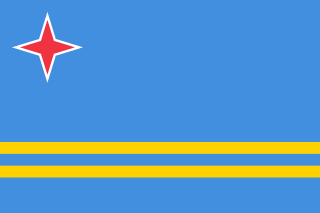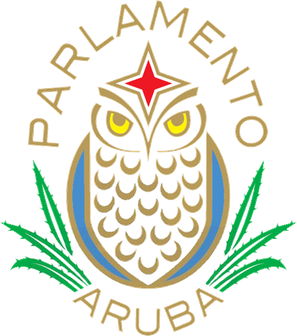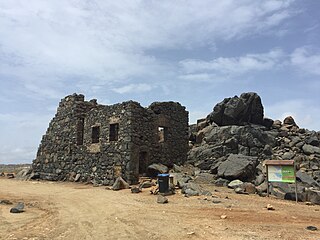
Aruba, officially the Country of Aruba, is a constituent country of the Kingdom of the Netherlands physically located in the mid-south of the Caribbean Sea, about 29 kilometres (18 mi) north of the Venezuela peninsula of Paraguaná and 80 kilometres (50 mi) northwest of Curaçao. It measures 32 kilometres (20 mi) long from its northwestern to its southeastern end and 10 kilometres (6 mi) across at its widest point. Together with Bonaire and Curaçao, Aruba forms a group referred to as the ABC islands. Collectively, these and the other three Dutch substantial islands in the Caribbean are often called the Dutch Caribbean, of which Aruba has about one-third of the population. In 1986, it became a constituent country within the Kingdom of the Netherlands, and acquired the formal name the Country of Aruba.

The economy of Aruba is an open system, with tourism currently providing the largest percentage of the country's income. Because of tourism's rapid growth in the last 80 years, related industries like construction have also flourished in Aruba. Other primary industries include oil refining and storage, as well as offshore banking. Despite the island's low rainfall in the past year, the people have proven that Aruba's soil is full of nutrients and many crops do amazingly well in the soil. Many more locals have started participating more to horticulture, permaculture and agriculture. Creating a start to an internal economy. Aloe cultivation, livestock, and fishing also contribute to Aruba's economy. In addition, the country also exports art and collectibles, machinery, electrical equipment, and transport equipment. Aruba's small labor force and low unemployment rate have led to many unfilled job vacancies, despite sharp rises in wage rates in recent years.

Gilberto François "Betico" Croes was an Aruban political activist who was a proponent for Aruba's separation from the Netherlands Antilles. This eventually occurred in 1986, but following a car accident on 31 December 1985, Croes lapsed into a coma and never became conscious to see his accomplishment. He is best remembered as "Libertador" (liberator) and as the father of the Aruban people.

Noord is a town and region in Aruba. This town is known for its low rise and high rise hotels, restaurants, beaches, malls, the California Lighthouse, and other places of attraction.

The Parliament of Aruba is the unicameral legislature or parliament of Aruba. The parliament has 21 members, elected for a four-year term by proportional representation. Each member holds their seats until the parliament is dissolved, which is every four years by a general election. The leader of the party which gains a majority of seats usually becomes the Prime Minister.

San Nicolaas is 19 kilometres (12 mi) southeast of Oranjestad, and is Aruba's second largest city. As of 2010 it has a population of 15,283, most of whom originate from the British Caribbean and rest of the Caribbean.

Bushiribana and Balashi are the sites of two former gold smelters on the Caribbean island of Aruba.

Palm Beach is a tourism district about 6 kilometers northwest of Oranjestad, the capital of Aruba. A number of high rise hotels are located there, such as Hyatt Regency Aruba Resort & Casino, Aruba Marriott Resort, The Barceló, Holiday Inn SunSpree Resort, Ritz Carlton Resort, and RIU palace Aruba. A shopping district adjacent to the hotels was finished in 2009 and includes two large malls called Paseo Herencia and Palm Beach Plaza Mall. Little North of Palm Beach is Malmok Beach, a small sandy strip running all the way until the northern tip of Aruba. Smaller apartment complexes and luxurious holiday homes are located along this dead-end Boulevard. Hadicurari Beach (kiting), Arashi Beach and Boca Catalina (snorkeling) are popular locations.

The Mechelen-Zuid water tower is a 143-metre-high (469 ft), combined water and telecommunications tower constructed in 1978. Since 1979, it has supplied the water to the city of Mechelen, Belgium, while also hosting television and telecommunications aerials. The concrete spire passes through a wide disc holding water fifty metres above the ground. Higher up, a smaller disc supports telecommunications equipment. Topped by a decorative stainless steel tube, it is claimed to be the highest water tower in the world.
The coastal city of Chennai has a metropolitan population of 10.6 million as per 2019 census. As the city lacks a perennial water source, catering the water requirements of the population has remained an arduous task. On 18 June 2019, the city's reservoirs ran dry, leaving the city in severe crisis.
There are approximately 16,000 operational desalination plants, located across 177 countries, which generate an estimated 95 million m3/day of fresh water. Micro desalination plants operate near almost every natural gas or fracking facility in the United States. Furthermore, micro desalination facilities exist in textile, leather, food industries, etc.
Francisco Dominico "Frans" Figaroa was an Aruban politician who served as Lieutenant governor of Aruba from 1979 until 1982, figaroa previously served as President of the Parliament of the Netherlands Antilles (1973-1979) and Minister of Education of the Netherlands Antilles (1961-1962), Figaroa also served as chairman of the Aruba Football Federation and chairman of the Netherlands Antilles Olympic Committee.

Lolita Euson was a Dutch Antillean writer and poet. She was invested as a Knight of the Order of Orange-Nassau, and streets in both Sint Eustatius and San Nicolaas, Aruba, bear her name. In 1996, she was memorialized by an Arubian stamp, which depicts her likeness.
Laura Simona Wernet-Paskel was an Aruban teacher, writer, and politician. She was the first female political candidate in Aruba, running for office three times beginning in 1949.

John William Merryweather was an Aruban landscape architect and politician. He served as the first Minister Plenipotentiary of Aruba from 1986 until 1989.

Plaza Hotel Curaçao is a former hotel in Willemstad, Curaçao. It was constructed in the Waterfort, and opened on 12 October 1957 as Hotel Curaçao Intercontinental. It is the tallest building on the island. The hotel has changed ownership many times. In 2017, Plaza Hotel Management was declared bankrupt. The hotel is in a dilapidated state, and pieces have fallen off. Viva Construction had been hired to assess the building prior to the 2020 auction, and reported that demolition was the best option. At the auction, it was sold to Algemeen Pensionfonds Curaçao, a pension fund which planned to redevelop the site.

De Olde Molen is a windmill in Palm Beach, Aruba. It was originally built in 1815 as a windpump in Winschoterzijl, Groningen, Netherlands. In 1897, it was moved to Wedderveer, Groningen where it served as a gristmill. In 1960, it was bought by Theo Paalman and G.J. Woudenberg, two Aruban businessmen, disassembled and rebuilt in Aruba. The windmill is home to a restaurant and a windmill museum. It is located next to the Bubali Bird Sanctuary.

City Hall is home to the civil registration of Oranjestad, Aruba. The building used to be a doctor's office and residential home of Eloy Arends. Aruba is only subdivided in regions and zones for administrative and statistical purposes, therefore, it is not a city hall defined as the seat of municipal government. The city hall is used for civil registrations, passports and marriages.
Antonius Johannes van Koolwijk was a Dutch clergyman of the Roman Catholic Church. His notable contributions lie in the field of archeological research, particularly his studies on the indigenous culture of Aruba, Bonaire, and Curaçao during the late 19th century. Van Koolwijk is recognized as the pioneering archeologist of the ABC islands.
















